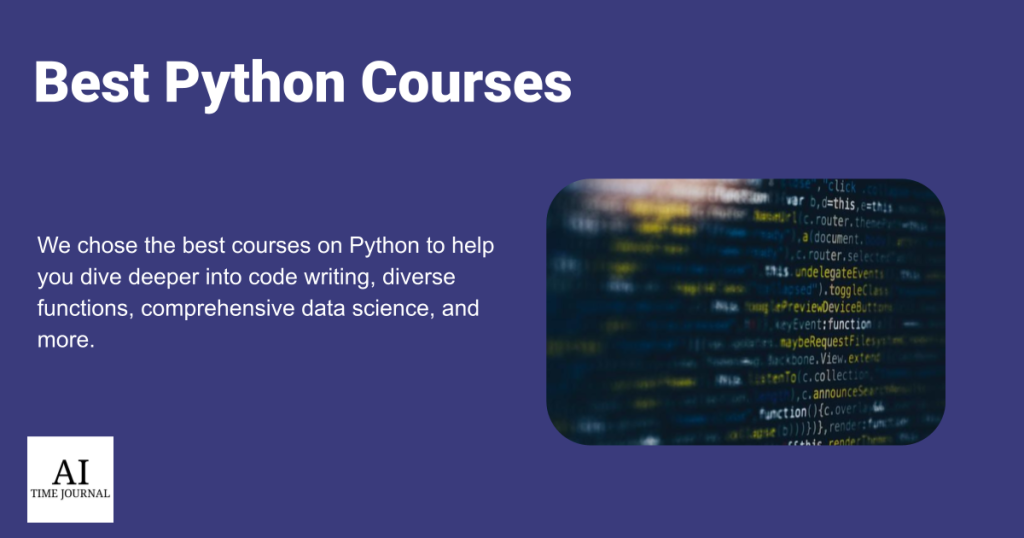
Most technologies are manifest expressions of the background power of programming languages. For instance, you can imagine the feat of Python in data science, deployed by government agencies in crime detection, defense, and cybersecurity. In AI for robotics and developing AI tools like ChatGPT. The list is endless. AI is largely one of the most incredible applications of Python. Therefore, this article will do you a great lifting by exploring the Best 5 Python courses (2024) you need to embark on your journey.
In this new decade, there has been a significant surge in Python-related job opportunities. Presently, over 11,000 job listings worldwide are related to Python roles on Glassdoor. Interestingly, when compared to Java-related roles, Indeed has almost twice as many listings for Python, a testament to the current vastness of the Python job market.
Given the circumstances, Python has created thousands of on-demand jobs worldwide. This has elicited many people’s attraction to the tech field. Yet, many folks don’t know where to begin.
Table of Contents
Top 5 Python Courses in 2024
These are interactive courses provided by Datacamp to make learning convenient. The courses contain an abundance of exercises to strengthen your use of your acquired skills.
Introduction To Data Science In Python
This introductory course is a good start with Data Science; it’s an easy-to-understand Python course to learn how to analyze and visualize data. Therefore, the objective is to become knowledgeable in basic Python syntax and common Data Science modules for charts, graphs, and tabular data.
The course instructor is a Lead Data Scientist, Hillary Green-Lerman. Course completion is estimated at 4-5 hours, and it is a beginner course. Also, no coding experience is required.
The scope of learning includes four chapters thus:
- Basics of Python syntax: Python modules and functions.
- Learn to read, modify, and search tabular datasets.
- Plot and visualize data with Matplotlib.
- Create new plots with scatter plots, bar plots, and histograms for profound data analysis.
In the end, you will apply your knowledge in solving a real-world case: The Mystery of Bayes, the kidnapped Golden Retriever.
Intermediate Python
This is a beginner course that will efficiently bolster your knowledge and application of Python. You will learn to use Matplotlib’s functions to visualize real data and deploy dictionary and pandas DataFrame effectively.
The course requires that you have existing knowledge of Python. Here, you will be guided by Hugo Bowne-Anderson, Data Scientist at DataCamp. The course duration is 4 hours containing five chapters with 18 videos and 87 exercises.
Course content includes the following:
- Learn Matplotlib for in-depth plotting.
- Apply pandas and dictionaries for datasheet manipulation.
- Learn Boolean logic, the basis of decision-making in Python for Logic, Control Flow, and Filtering.
- Loops for Python codes
- Real-life practical using Hacker statistics.
Object-Oriented Programming In Python
This is an in-depth course on Object-oriented programming (OOP). You will have insight into the principles of Object-Oriented Programming (OOP), which are conventional programming methodologies used to optimize time during the development process. The objective is to create blueprints for Python objects and apply pivotal principles to maintain, reuse and optimize your code. The course has four chapters.
The course curriculum is led by Alex Yarosh, a software engineer. This course is estimated to last for 4 hours containing 13 videos and 44 exercises. You must have basic knowledge of Python to adequately benefit from it. People that need this course mostly include software engineers, web developers, and game developers.
Course content includes:
- Fundamentals of OOP.
- Learn Inheritance and Polymorphism to reuse and optimize codes.
- Define and customize Python objects by string representation.
- Learn to design classes and blueprints for inheritance.
Writing Efficient Python Code
A time-saving course for data scientists. This is a complete course on writing Python codes that will lessen runtime and save up time for more concentration on data analysis. The objective is to gain competence in writing efficient, reusable codes deploying Python modules and functions. This course has four chapters containing 15 videos and 53 exercises.
The Course instructor is Logan Thomas, a scientific software technical trainer. The time for completion is 4 hours.
The entire scope of learning includes the following:
- Learn the foundation of efficiencies by applying Python’s built-in tools.
- Learn code timing and profiling using line_profiler and memory_profiler.
- Learn the complex tactics on efficiency using built-in modules and learn how to adequately modify loop patterns.
- Introduction to Pandas DataFrames
The course content is easy to flow with. Over 92,000 students have enrolled in this course already.
Writing Functions In Python
This is a practical course on applying your model to production. Here it is intended for you to become a Python expert. You are taught how to write complex functions that can be maintained and reused. You will acquire research and engineering skills. This course has four chapters containing 13 videos and 46 exercises.
The course instructor is Shayne Miel, an expert, and director of software engineering. This course is estimated to last for 4 hours.
Course content includes the following:
- Best Practices on Writing Python Function.
- Context managers to provide connections
- In-depth use of decorators to modify Python functions for best results.
- Learn advanced decorator functions with real-life projects.
This course has a record of over 60,000 learners. Made to make you become an expert in Python in order to contribute immensely where research and software engineering is pivotal.
Conclusion
As time progresses, the profound significance of information technology continues to reveal itself. There were periods when mastering a machine language was neither trendy nor mainstream but reserved for a select few.
However, the 21st century has uncovered the rewarding prospects that lie within the IT field. High-level programming languages have become the norm. Python, in particular, has gained substantial attention. It is widely believed that learning Python provides the tools to create remarkable innovations in the world.
